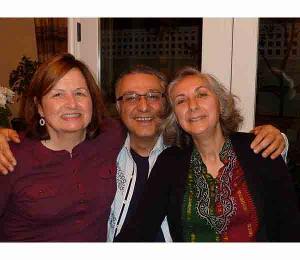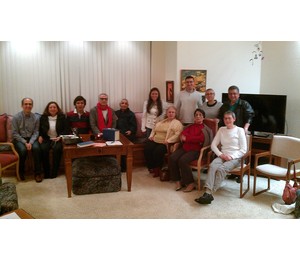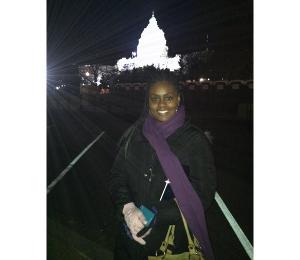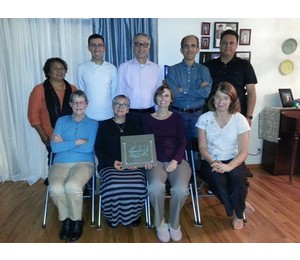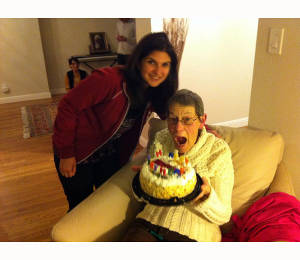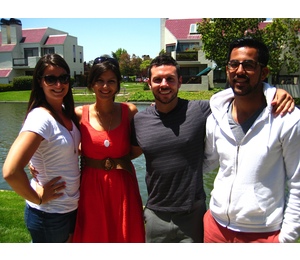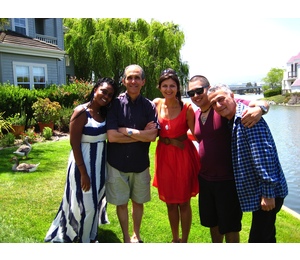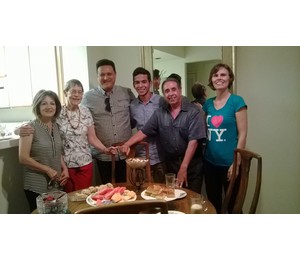On July 9th, Bahá’ís in Redwood City gathered to commemorate the martyrdom of the Bab. Baha’is trace the founding of the Baha’i Faith to the “Twin Manifestions”, the Bab and Baha’u’llah.
Who is the Bab?
Events in the life of the Bab and His followers, who numbered in the thousands, figure prominently in the history of 19th century Persia; all reliable histories of 19th century Persia include coverage of these truly historic events. In the early 1800’s when Adventist Christian groups were predicting the immiment fulfilment of important Biblical prophecies based on numerical calculations from the words of Christ and the Book of Daniel which pointed to the year 1844, Moslem groups in Persia were simultaneously expecting the immiment fulfilment of important Islamic prophecies. Followers of one of these groups encountered a young merchant in Shiraz who in 1844 proclaimed a new revelation under the title of “the Bab” which means “the Gate” in Persian. Although this title was originally misunderstood, it later became clear that He claimed to be the channel of grace from some great Person still concealed from the eyes of men; that He was the Gate to this great Person. In the Baha’i Teachings the revelation of the Bab is represented as something akin to “shock therapy” preparing the Moslem community in particular, and mankind in general, for the great changes that would be ushered in by the subsequent Revelation of Baha’u’llah; the great Day of God foretold in the scriptures of the Great Religions of the World.
Short eventful Ministry
The Bab was a youthful 24 years of age in Shiraz, Persia in 1844, when He declared Himself to Mulla Husayn, the first to believe in Him. Within a few short years his followers would number in the tens of thousands. So sure were they of the truth of His Divine mission that thousands of them would willingly accept death when confronted with the choice of death or denial of their faith in the Bab. Many of these merciless martyrdoms were witnessed by western witnesses who have left written first-hand accounts of the harrowing events. The ensuing drama of His ministry would sweep into its vortex the Shah of Persia, the governors of three of its most important cities (Shiraz, Isfahan and Tabriz) together with hundreds of religious leaders from the entrenched Shiah Moslem religious hierarchy.
The people among whom He appeared were the most decadent race in the civilized world, grossly ignorant, savage, cruel, steeped in prejudice, servile in their submission to an almost deified hierarchy, recalling in their abjectness the Israelites of Egypt in the days of Moses, in their fanaticism the Jews in the days of Jesus…
–Shoghi Effendi
Opposition and Martyrdom
Most of the Persian Shiah Moslem hierarchy wached with dismay as the renown of the Bab rose so quickly in 1844 and they saw in His teachings a direct threat to the stranglehold they maintained over the consciences of an abject and fanatical populace. A significant number of key religious leaders in Persia accepted the claims and teachings of the Bab but they were vastly outnumbered by the majority who were determined to stamp out -by any means necessary- the rising influence of the Bab and the ever-rising numbers of His devoted followers. They conspired with the government at first to openly challenge and disparage the Bab and then to banish Him to a prison in a remote corner of the land (Tabriz) in the hope that cutting off His followers from their Leader would seal the doom of this incredibly vibrant movement. But it was not to be; the imprisonment only led to an accelerated growth of the movement, to an increase in its renown among the populace and finally to the open clash forever etched into the pages of 19th-century Persian History.
The final decision to execute the Bab did not come about through any legal or judicial process. That wasn’t possible since He enjoyed a very high reputation in the country and it was well known that he had not committed even the slghtest legal infraction. In the end, the Shah’s Grand Vizier ordered the Governor of Tabriz to execute the Bab but the governor flatly refused to perform what he regarded as an obvious crime. Undeterred, the Grand Vizier ordered his own brother to carry out the unholy act.
Gate to the Great Day of God
The Bab was 31 years of age on July 9th 1850, when a second firing squad of 750 men raised their rifles to carry out an order designed to brutally and permanently extinguish the movement inaugurated by a youthful Siyyid who maintained throughout His brief six-year ministry that he was the “Gate”; the channel of grace from some great Person still behind the veil of Glory. The amazing crescendo of His renown in Persia in the space of just a few short years came about not as a result of personal charisma but because He was, like the other Prophets of God, a true Educator. His copious writings and teachings had explained questions and mysteries that had formerly been confusing to the minds of the Persian Moslem community lifting His disciples from the darkness of ignorance toward the light of virtue. He truly prepared the way for the Great Day of God and subsequent events would abundantly affirm the appropriateness of His title “The Gate”.
Shrine on Mount Carmel

On the night of His Martyrdom, the remains of the Bab were secretly secured by some of his followers and hidden. For decades they were moved from hiding place to hiding place until, fifty-nine years later they were transferred to their final resting place in the Shrine on the “Mountain of God” in what was then Palestine and is today Haifa, Israel – pilgrimage destination for millions of Baha’is around the world. Today Baha’is around the world recognize the Bab and Baha’u’llah as the “Twin Manifestations”, the founders of the Baha’i Faith.


